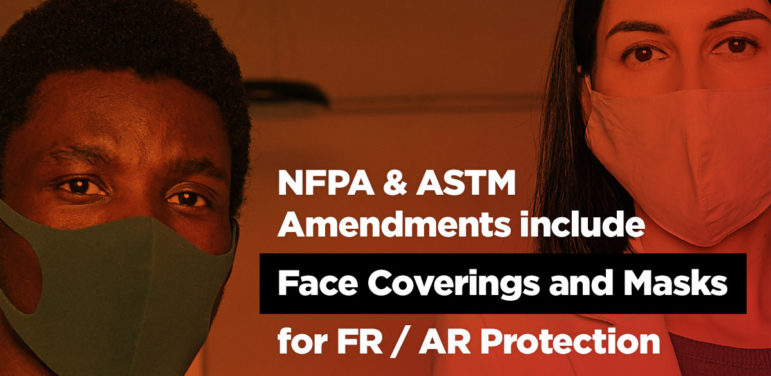Face Coverings and Masks:
Since the spread of COVID-19 pandemic and with the growing need of using Face covering or masks as the most efficient mode of protection, there has been an increasing demand by the global work force to provide Flame resistant & Arc rated masks / face protection.
Medical associations and experts globally reviewed and affirmed that cloth face coverings are a critical tool in the fight against COVID-19 that could reduce the spread of the disease, particularly when used universally within communities.
Considering the recommendations, it was important that these products get covered by the universally acceptable standards for Flame resistant and arc rated categories. Work had been going on in this regards and NFPA & ASTM norms have finally approved these products to be covered under their scope of approvals.
This blog provides information on the inclusion of masks / face coverings under the scope of NFPA 2112 for Flash Fire protection and under ASTM F1506 for the Arc rated clothing material.
We have also tried to cover the information on how a non arc rated product can be evaluated under the ASTM F2621 norm.
NFPA 2112 – Temporary Interim Amendment (TIA) approved:
The NFPA Standards Council has approved 2112 TIA 18-1. With this TIA, NFPA 2112 now includes flame resistant cloth face coverings in its scope. The council had been working to address masks in FR standards since the Centre of Disease Control & Prevention (CDC) cloth face covering recommendations were handed down in April 2020. End-users wanted to know that they’re safe while wearing face masks on the job. Many manufacturers are now making and selling flame resistant face masks. The newly approved TIA now allows those manufacturers to label the masks as NFPA 2112 Certified. That gives end-users the assurance that their mask is safe to wear in a flash fire exposure.
NFPA 2112 requires third-party certification for any clothing material, however, since these FR face coverings are needed immediately, it was important to eliminate delays in the certification process. The new TIA therefore allows FR face coverings to be certified by self-declaration by the manufacturer. The only requirement is that the face covering just has to be made of NFPA 2112 certified components like fabric, thread etc. if any.
ASTM F1506-20a – Includes Flame resistant Cloth Face covering
A new edition of ASTM F1506-20a has been published now. This edition adds flame-resistant cloth face coverings (FRCFCs) to the scope, with reduced labelling requirements. According to the new edition, FRCFC is defined as “a flame-resistant fabric-based garment, primarily covering the nose and mouth, designed to reduce community spread for biological hazards”.
It is important to note that the standard makes it very clear that FRCFCs are not designed to provide arc protection for the face, head or neck.
Although the FR Cloth Face covering material is still required to meet all other requirements of the ASTM F1506, this edition of the standard allows for reduced labelling requirements due to the size of the FRCFC. As a minimum, ASTM F1506 compliant FR Cloth Face Coverings must have the following on the label:
- “FRCFC ASTM F1506 – Not arc flash face protection”
- The tracking ID code
While the limited labelling is permitted, manufacturers wishing to apply full ASTM F1506 labels to cloth face coverings are permitted to do so, provided the label does not add to the severity of injury to the wearer. This edition does not remove any of the product conformity assessment requirements in the F1506-20 edition.
Evaluation of Non-Arc rated products in an Electric Arc exposure:
The recently updated ASTM F2621 now allows for the evaluation of non Arc rated products in an electric arc exposure. The Standard had previously limited evaluations to only arc-rated products. This prevented users from evaluating products that were necessary for the job but were not available with an arc-rating.
Why expose Non-Arc-Rated products to an Electric Arc?
There are many instances where electrical work is performed in areas with multiple hazards. The secondary hazards may require other specialty PPE products. Some products don’t have any standard test methods designed to provide an arc-rating. But product manufacturers and end-users need to perform due diligence before placing the product into service. ASTM F2621 can now shed light on what happens to these products when they are exposed to the arc.
Few examples would be respirator, torch, fans etc. These products at times become imperative when electrical work is required in an area with a hazardous environment. But there is no standard to assign an arc rating to these products. Being able to visualize how these products would respond to an arc exposure is a key due diligence step. If the non-arc-rated product doesn’t ignite in the exposure, it’s likely that it will not contribute to the extent of any burn injuries. However, knowing that the product ignites and melts onto the manikin can help to avoid catastrophic failure in the work areas.
However, it is important to recognize that this product evaluation does not provide an arc-rating on these products. It is simply a tool to evaluate how the product would respond in the exposure.


Leave a Reply